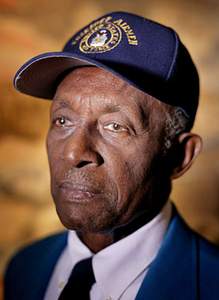2nd Lt Richard D. Macon took off in a P-51 on an escort mission to bomb radar stations in Toulon. The mission was successful, but the fighters of his wing began drawing fire. Macon was hit by flak, flipping his plane upside down and setting it on fire. Struggling to control his plane, Macon passed out, slumping against the control stick and sending his plane into a loop and ejecting him from the cockpit. Somehow his parachute opened, and he woke up 45 minutes later surrounded by several German soldiers. With a broken shoulder and neck, causing him to pass out at sudden movements, he was moved from the field hospital to Stalag Luft III near Sagan, Germany, where his neck was finally braced. More Allied advances moved him to Stalag XIII-D at Nuremberg, and then Stalag VIIA at Moosburg, where he spent the rest of the war. He was one of the Tuskegee airmen. He died on October 9, 2007, at John D. Dingell VA Medical Center in Detroit at the age of 86 and is now buried in the Arlington National Cemetery, Arlington, Arlington County, Virginia, USA. He was a famed Tuskegee Airman.
From the CAF Website:
Capt. Richard D. Macon
August 21, 1921 – October 9, 2007
Class 44-B-SE
Unit 99th Fighter Squadron
Born in Birmingham, Ala., Macon earned a degree in mathematics from Miles College in 1942. A year later, he joined the Army Air Forces and graduated from the segregated flying school for black airmen at Tuskegee, Ala., to become a fighter pilot. He passed, graduating from flight training on Feb. 8, 1944, at Tuskegee Army Air Field in Alabama. He soon deployed to Italy with the 302nd Fighter Squadron.
On Aug. 12, 2nd Lt. Macon was part of an escort mission to Toulon, France, to destroy radar stations. The target was destroyed, but the fighters drew ground fire. Lt. Langdon E. Johnson and Lt. Joseph E. Gordon were hit by anti-aircraft fire, or flak, and killed.
Macon also was hit by flak, flipping his plane upside-down before it burst into flames. As he struggled to straighten the plane, Macon passed out, falling against the control stick. His plane was thrown into a loop, tossing him from the P-51 Mustang. Somehow, as he fell, his parachute opened. When he woke 45 minutes later, he was lying in a field, surrounded by three German soldiers.
Macon was taken to a field hospital, where he was diagnosed with a broken a shoulder and broken neck. Doctors set his shoulder, but with Allied troops approaching, the Germans moved before setting Macon’s neck. A few days later, Macon met fellow prisoners of war 2nd Lt. Alexander Jefferson and Capt. Robert H. Daniels.
“(Macon) was in bad shape and appeared to have a fractured neck because every time he moved abruptly, he passed out,” Jefferson wrote in his book, “Red Tail Captured, Red Tail Free.” “We braced his neck and head to make them immovable. When we got him up the next morning, he had to walk very slowly, trying not to move his head.”
Two weeks and several hundred miles later, the group arrived at Stalag Luft III near Sagan, Germany, and were split up. Macon was sent to the hospital where his neck was finally X-rayed and set. Before he could recuperate, Russian troops forced the Germans out of Sagan. Macon, his neck in a cast, was taken to Stalag XIII-D at Nuremberg. When American troops advanced on Nuremberg, Macon was moved to Stalag VIIA at Moosburg. He was held there until the end of the war.
Promoted to captain, Macon was honorably discharged in December 1945. According to military records, he was awarded an Air Medal and a Purple Heart for his military service.
Captain Macon. Photo courtesy Brian Shorkey
After leaving the Army, Macon organized a flight school in Birmingham, Ala., in 1946. Macon learned that multimillionaire Howard Hughes controlled three hangers at the Birmingham Airport, and set up a meeting. When it was over, Hughes gave Macon permission to use part of a hanger for his flight school.
“I was very fortunate,” Macon said in a 2005 interview with The Michigan Citizen in Detroit. “Blacks couldn’t go to the airport as passengers. I was going there now as a businessman.”
Macon earned a master’s degree in math from Indiana University before returning to Miles College as an associate professor. In 1956, Macon accepted a teaching position at Detroit Public Schools; he retired in 1987. Macon and Jefferson helped found Tuskegee Airmen Inc. and each served as president of the Detroit chapter.
Macon died Oct. 9, 2007; he is buried at Arlington National Cemetery in Arlington, Va.

PRIVATE CITIZENS SUPPORTING AMERICA'S HERITAGE
American
War Memorials Overseas, Inc.
War Memorials Overseas, Inc.
Macon Richard D.
Name:
Richard D. Macon
Rank:
Captain
Serial Number:
O-821916
Unit:
99th Fighter Squadron, 332nd Fighter Group
Date of Death:
2007-10-09
State:
Alabama
Cemetery:
Arlington National Cemetery, Virginia
Plot:
Section 54 Site 886
Row:
Grave:
Decoration:
Air Medal, Purple Heart
Comments:
